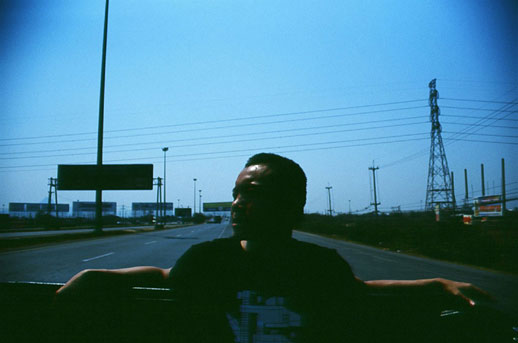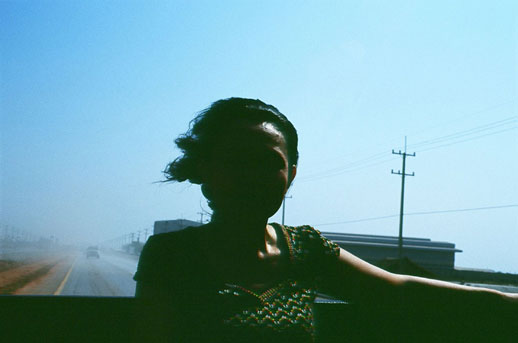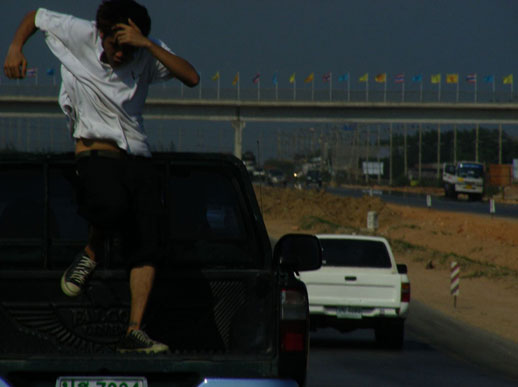Shuttling Around
Apichatpong Weerasethakul is a storyteller who carries no script with him. The ‘script’ is not decided on in advance, and he makes few demands on it, letting it unfold by itself, and allowing it to direct the whole performance, supplying its own sound, movement, and texture.
The central piece in this exhibition is a four-channel video installation titled Unknown Forces. Ostensibly, the main subject of the videos is the political turmoil of 2006 following the military coup in Thailand, but far more everyday and insidious ‘forces’ propel these works.

Two of the videos show day laborers in northeastern Thailand (where Weerasethakul was raised), sitting on the back of a pickup truck, hurtling across a mundane, parched landscape towards their next destination, where they will be dispatched to their next temporary workplace. As the highway recedes behind them in one extended tracking shot, the wind screams above their voices; with no subtitles, one listens to the sound of them speaking Thai and imagines them to be relating personal anecdotes to each other. Weerasethakul hitchhikes on the back of a vehicle along with its human cargo and records the trajectory of that experience: the unsettled nature of a daily existence in which one is trafficked across the expanse of a country so as to fuel its restless economy. Poignantly, you get a glimpse of the motorway billboards of Hino, Nissan and Toyota, an incidental allusion to Japanese corporations that fuel the hidden engines of Thailand’s economic growth.

The installation could easily have degenerated into a heavy-handed look at the marginalized victims in a globalized economy, but Weerasethakul’s delight in the medium of video conveys too much of a joyous sensibility for that. Those same ‘unknown forces’ are a source of dynamism, the simple thrills of speed and movement. A third video shows another pickup truck with an energetic young man standing on the cargo deck, breaking out in a freestyle dance, his frenetic, jerky movements mirrored by the shuddering of the camera as it is buffeted by the airflow. This is a road trip, but not his own. And yet, despite being shuttled around like a commodity, he is riding the wind out on this moving stage, giving himself up to the joy of a desultory journey. Compare this to a very different kind of labor-shuttle: the sullen looks of death on a weekday morning commuter train in Tokyo.
Weerasethakul presents us with an act of self-transport, a man dancing outside of himself and losing himself in the movement. There is a poignant irony in the way he gives himself up to the rhythm, just as his labor is to be given up to a cross-country network of construction industries.

The audience can experience something of this roaming journey, too: put on the wireless headsets that provide the soundtrack to the videos, and you hear the music the young man is dancing to. It is the sort of slightly clunky analog techno made by layering synthesized electric organ tones and 8-bit effects, which Weerasethakul himself said strikes him as particularly ‘Japanese’. However, the musicians are Thai; an electro-pop group called Cyndi Seui from Bangkok. Move closer to the other two videos, though, and you pick up scraps of a half-heard story deafened by the howling wind. Walking around from one video screen to another, the soundtrack shifts and changes, thanks to another ‘unknown force’: the interactive wireless sound system, designed by three sound artists – Hiroyuki Takahashi, Daito Manabe, and Motoi Ishihashi.
The final video in the installation presents you with the sort of oblique image that often accompanies the ‘narrative’ in Weerasethakul’s longer feature films: a kind of surreal set-piece that seems misplaced, but which in fact resonates with the rest of the work at some latent, subconscious level. There is a tent in a forest clearing, shrouded by billowing smoke and the glare of standing spotlights, as well as flashing, candy-colored fluorescent tubes. It comes across as a cheap parodic spectacle of some horror B-movie film set, a kind of outtake from his other films set in the rural wilds of his native Thailand, like Tropical Malady and Mysterious Object at Noon. Listening to Cyndi Seui’s electropop riffs while the fluorescent tubes flash pink, blue and yellow is like watching the fallout of a pop concert being razed by ‘unknown forces’ – the same ones responsible for the shuttling of the day laborers in the other videos. To every force, its opposite and equal reaction: accordingly, the laborers react, each in their own way, to these invisible tensions that govern their trajectory across this landscape of highways. To defuse them, they chatter among themselves to while away the hours, or dance in the wind. Here, however, the forces themselves have conjured up form of their own by animating an empty stage set, like a phantom orchestra hamming it up in the pit once all the musicians have left. In this sudden burst of light and sound in the dark, Weerasethakul has cornered those unknown forces and made them sparkle for our enjoyment.
Darryl Jingwen Wee
Darryl Jingwen Wee



